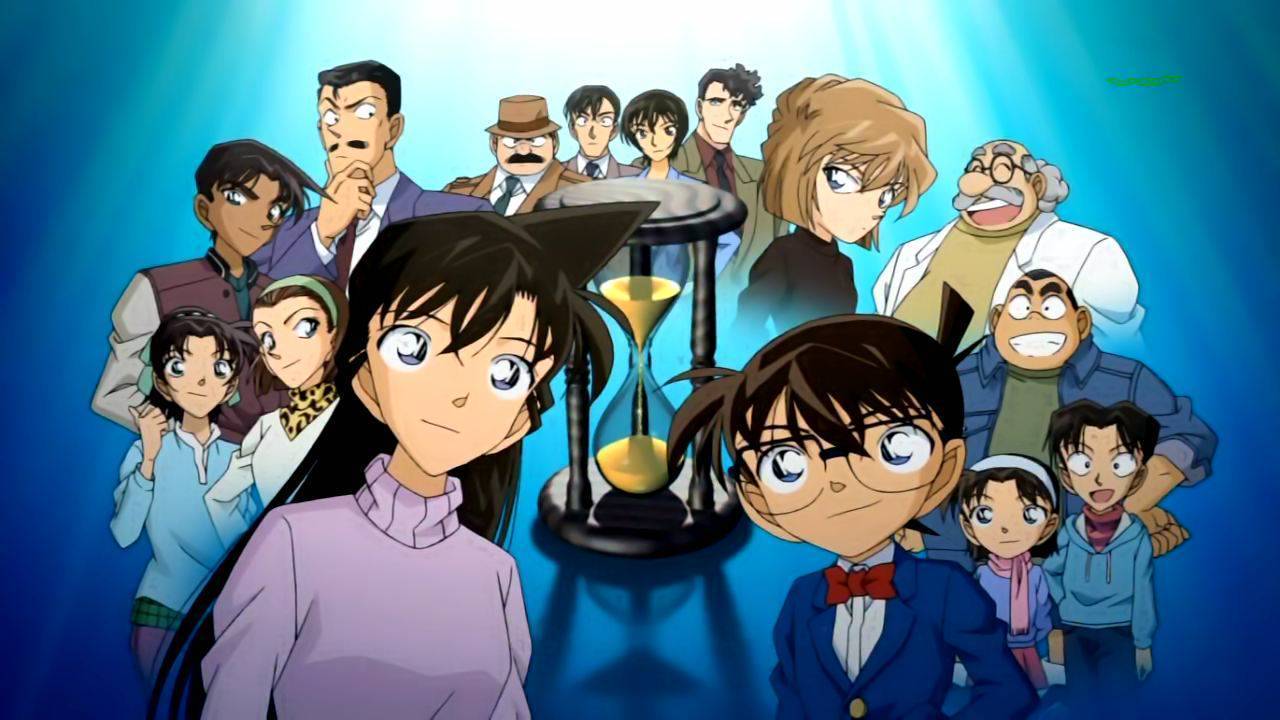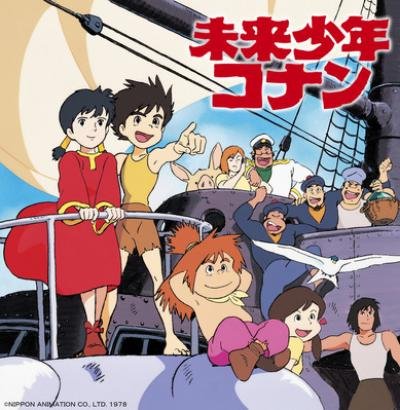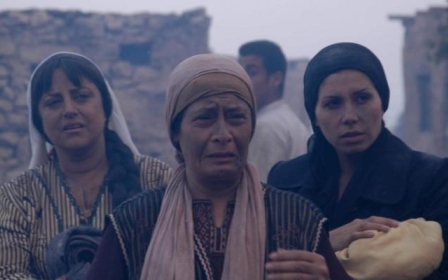Why Anime has such deep roots in the Arab world

Aws ibn Jubair follows the classic hero's character arc: an everyday man moulded by circumstances beyond his control into a legendary warrior.
“Everyone has something worth protecting,” ibn Jubair declares, as he stares out at the enemy in front of him with kohl-blackened eyes.
New MEE newsletter: Jerusalem Dispatch
Sign up to get the latest insights and analysis on Israel-Palestine, alongside Turkey Unpacked and other MEE newsletters
Inspired by a famous pre-Islamic Arabian tradition, which is also mentioned in the Quran, The Journey is a modern-day re-telling of the Aksumite invasion of Mecca by Abraha, a southern Arabian king, who sought to destroy the Kaaba and replace it with his own temple, helped to that end by his legendary elephant-mounted army.
Standing in their way is ibn Jubair, a potter by trade, whose initial goal of protecting his family suffers from the mission creep characteristic of all epics: stopping the invasion against all odds.
The character of ibn Jubair may be fictional but the financiers of the film Ar-Rihlah (The Journey), in which he is the protagonist, hope he will become a name as familiar in the region as the mythical Arabian heroes of ancient times.
Essam Bukhary, the film’s lead producer, and CEO of the Saudi company Manga Productions, has said the film is a way of “exporting Saudi culture and the historical stories the Arabian Peninsula retains”.
To that end, producers have sought to balance indigenous storytelling with a format that has appeal both within the region and internationally. So, while the story is rooted in Arabian tradition, the movie's aesthetics are anything but. Instead, it finds its inspiration in anime, the name given to Japanese animation.
Collaboration
The film is the first feature-length animation jointly produced by Saudi Arabia, through its cultural vehicle the MiSK foundation, which owns Manga Productions, and Japan’s Toei Animation, famed for productions such as Detective Conan and 80s cult classic UFO Robot Grendizer, usually known as just Grendizer.
The film uses 4DX technology to make viewing a more immersive experience and has so far been voiced in both Arabic and Japanese for those respective markets.
“I thought it was an excellent mix of Arab tradition and Japanese story-telling. I hope we see more anime of this genre,” says Anwar Abu Taha, a 35-year-old engineer who grew up in Saudi Arabia on a steady diet of anime and watched the film in Arabic when it was released across Saudi cinemas last month.
“Growing up I loved Arabian Nights: Sindbad's Adventures. The adventures were amazing and it had many fables that intend to teach you lessons in life. When I was older it was Death Note," he added, referring to the dark young-adult anime, which features a boy who finds a powerful notebook that causes anyone whose name is written in it, to die.
“It gave me a real understanding about good and evil, but it also addressed philosophical ideas that made me think more about how our minds are wired.”
Anime in Arabic
Love of anime is far from being a niche sub-culture in Saudi Arabia or the wider Middle East. A 2019 YouGov poll conducted across the MENA region showed Saudi Arabia had the largest anime audience in the region.
Manga Productions was set up in 2016 to train Saudi animators in producing home-grown animation. It has also previously produced a mini-series Kanz al-Hattab (or the Woodcutter's Treasure), which aired on Japanese TV in 2018.
Saudi-Japan relations are well-established, with Saudi Arabia being the largest source of Japan's oil imports, supplying 40 percent of its crude oil.
In 1972, The Japan Foundation, a cultural exchange programme, was established, and it started co-sponsoring students in state-of-the-art technical colleges in Saudi Arabia.
Co-producing anime projects appears to be Saudi’s latest mode of cultural exchange.
According to Kristin Smith Diwan, a senior resident scholar at the Arab Gulf States Institute in Washington, such endeavours can help Saudi Arabia exert influence abroad beyond the realm of energy.
“Saudi Arabia’s new leadership is very keen to engage youth in all forms of media and arts and to bring them under the national mantle. It is a way to project Saudi identity and influence abroad and also to diversify the economy through new creative fields. Both are top priorities,” says Diwan, an expert on generational change and nationalism in the GCC.
“It is worth noting that there were Saudi Millennials forging their own path in animation and film before the new Saudi government came to power. In that sense, MBS and his MISK Foundation have been courting and accelerating a field where young Saudis had already demonstrated interest and some talent.”
Riyadh is not alone in creating homegrown anime. In 2013 in the neighbouring UAE, Abu Dhabi-based Alter Ego Productions created Torkaizer. The series follows an Emirati boy who travels to Japan after graduation and there discovers his mission to save the world from alien invasion.
Further away, Turkey already has a well-established production base with more than 30 animation studios and has produced more than a dozen anime feature films in the last 15-years.
Omar Al-Ghazzi, an assistant professor of media and communications at The London School of Economics (LSE), says popular entertainment is an important front in the exercise of a state's influence, alongside other forms of media.
“Usually, when thinking about government influence on the media, people think of news. But Arab entertainment television, whether TV series or indeed cartoons are also part of efforts to extend a state’s soft power,” Al-Ghazzi says.
“It is no surprise that today countries like the UAE and Saudi Arabia are investing in children’s productions as that is seen as an important part of their status as big media players in the region and beyond.”
Same cartoons, same channels, same time
The Middle East’s relationship with anime goes back decades. Children growing up in the region in the 1970s and 1980s enjoyed dozens of Japanese-produced cartoons dubbed in Arabic.
“Captain Majid (originally Captain Tabasua) and Adnan wa Lina (originally Future Boy Conan) were my favourite”, says Mohammed Ramadan, from his home in Amman, Jordan.
“We had Tom and Jerry and Mickey Mouse too, but we preferred to watch anime, because there was a strong lead character, a compelling storyline, and always a noble point to the episode.
“If we had the choice between Disney and Anime we would always choose the Japanese cartoons as there was always something to learn from the programme,” says the 42-year-old accountant.
Amer Mango, also from Amman, but now living in Tokyo, says: “We saw Mickey Mouse as the starter, the warm-up act, but the anime was the actual main course, that’s what we would wait for. We’d watch the other cartoons to prepare ourselves for the main course.”
Ramadan and Mango, like other children growing up in the Middle East in the 80s, were able to watch a daily dose of the Japanese imported shows at set times.
“The streets in Jordan would be empty when these programmes were on, as soon as it finished, we’d go out to play and imitate the martial art moves we’d seen in Grendizer or the football moves from Captain Majid ,” Ramadan recalls.
"I’d gather with my cousins and siblings in my parents’ living room every weekday from 4 pm to 6 pm.
“If an episode was aired and we were not at home, we’d call Jordan TV and ask them to put a re-run of the episode, and they would.”
Waiting and watching for the children’s time slot on TV after school or on the weekend became a ritual for children in the 1980s growing up in the Middle East, says Al-Ghazzi.
After the national anthem, and a recitation of Quranic verses, stations aired the ‘children’s segment’ and its Japanese content, he writes in his research paper, Grendizer Leaves for Sweden.
Al-Ghazzi says: “unlike today’s individualised children’s cartoons that are available on 24-hour cable channels or online, children in the 1980s watched the same cartoons on the same channel at the same time.”
Television stations began broadcasting in the Arab World from the late 50s, with Iraq paving the way and Lebanon closely following. By the mid-1970s, all Arab states had their own government-owned television stations.
They would air state-sponsored news and other light-entertainment shows, along with mostly Egyptian produced series or musalsalat, but there wasn’t an established production base for children’s TV.
“If an episode was aired and we were not at home, we’d call Jordan TV and ask them to put a re-run of the episode, and they would.”
- Mohammed Ramadan, Anime enthusiast
The Gulf Cooperation Council Joint Production Institution was set up in 1976 to commission and create content for the Arab member states countries bought cartoons from Japan. It had already started successfully turning its comics (manga) into cartoons and exporting them to America and Europe.
The animations were then dubbed by companies in Lebanon and Syria.
Nicolas Abu Samah's company Filmali dubbed the Adventures of Sindbad in 1974, and Zena Wa Nahoul (Maya and the Bee) in 1975. The Al-Zahra Centre in Damascus, Syria, dubbed Detective Conan, Captain Tsubasa, and Dragon Ball, to name a few.
“There was of course American content such as Tom and Jerry, but Japanese anime was by far the most popular. There was also Arab-produced content, such as the Kuwait production of Sesame Street. In Arabic, it was called Iftah ya Simsim (or Open Sesame), and a similar educational show called Al-Manahil was produced in Jordan.” Al-Ghazzi says.
Theme tunes and national anthems
Bassam Aldhahir, a pharmacist from London, grew up in Baghdad in the 1980s and enjoyed watching the shows, saying: “It was good wholesome fun, but not something I’d watch today and now there are so many cartoons out there, with amazing graphics, so kids have so many more options.
“Of course I realised the shows I watched weren’t Arabic productions, apart from Grendizer, I thought that was Arabic – I was quite surprised when I found out it wasn’t when I was older,” he says.
By far one of the most popular anime’s in the region, Grendizer is about a giant robot from another planet who saves the earth from enemy attack.
“Grendizer’s theme tune sounded like a national anthem, a military parade, it resonates coming from Iraq,” says Aldhahir.
Al-Ghazzi explains that the process of dubbing was key to anime’s popularity in the Arabic-speaking Middle East at the time. “… the cartoon’s jingles and lyrics were infused with nationalist messages and slogans.”
The opening lyrics to Sasuke - a story about a ninja boy who fights villains - were comparable to Arab nationalist slogans taught at school Al-Ghazzi says.
“'Rise up, put your hand in my hand, rise up to defend your tomorrow and mine; we shall defend our land; with our blood we shall defend it', are the words to the Sasuke theme tune. They mirror the dominant political rhetoric at the time".
Lost in translation
The original anime shows were a reflection of Japanese culture, but the producers behind the Arabic dubbing of Japanese anime were not interested in the subtlety and complexity of its meaning in Japan, but in adapting them to local and regional Arab political cultures, explains Al-Ghazzi.
“The nuances about Japanese political culture, for instance, or the resonance of the themes of nuclear warfare and post-apocalyptic futures were lost in translation," says Al-Ghazzi.
“The nuances about Japanese political culture, for instance the resonance of the themes of nuclear warfare and post-apocalyptic futures, was lost in translation when it came to the reception of Arab children”
- Omar Al-Ghazzi, assistant professor of Media & Communications at LSE
Anwar Abu Taha notes he didn’t realise the shows were at all Japanese until he was much older. “I used to think that they are completely Arabic.” But it wasn’t of importance to a young Abu Taha, his fascination was and still is with the show's plot structure, or Kishotenketsu.
“It’s never been about the characters for me, it’s the highly-developed plot structure which is different to western cartoons. Kishotenketsu, which follows a narrative that has unexpected twists, that’s what makes anime so compelling.”
But it's something he says he wasn't sure was present in The Journey.
"I'm not sure if The Journey followed it or not. In some anime it's really clear, but in this one, if the producers used the Kishotenketsu style it was more subtle. The film still works because of the fight scenes [grand-scale battles in the desert] and the side stories of miracles and earlier prophecies all help the main story develop and move along.”
Kishotenketsu is one reason why the genre of anime is now so popular, he says - with it’s own section in popular streaming services like Netflix, Amazon Prime, and Crunchyroll - but it’s not the only ingredient.
“Anime’s success, I think it’s down to a combination of the colours used, the detailed character animation, the epic fight scenes, how humour is used to diffuse tense situations. There are many layers to anime that you don’t always find in other forms of entertainment.”
Bringing culture back
Amer Mango, the 35-year-old Jordanian, who grew up in Saudi Arabia, would reenact scenes from Captain Majid in the playground when he played football with his friends. “I related to Bassam, one of the characters in the show, he was a big guy and I was taller than most of the kids in my class, so I used to pretend to be him when playing football.”
Mango says his main fascination with the anime's of his childhood was the mechanics behind Captain Majid’s spinning ball or the robotics behind the giant robot heroes he saw in Dinosaur War Izenborg (Arrajol Alhadidi or Iron Man), and Grendizer.
“The reason I studied engineering was because of a show called Sanshiro. It’s about a guy who used to make robots that fight in a ring and he’d do maintenance, it motivated me to think more about robotics, and one day create my own.”
But while studying engineering, Mango faced a Kishotenketsu plot twist of his own. He encountered a visiting Japanese professor who would meet him at his grandmother’s home to teach him Japanese. His language skills took him to Japan where he ended up working in sports management.
Watching The Journey in Japanese in a Tokyo cinema last month, with his wife who is half-Japanese and half-Jordanian, he says it’s the little details in the film that made it work.
“It was amazing, they even Japanised the names so the lead character Aws, was Awsu."
Noting the cinema was filled with a Japanese audience, he adds: “Anime is a huge part of Japanese modern-culture and if we want to approach Japan and have better cultural understanding, the best way is through anime."
Middle East Eye delivers independent and unrivalled coverage and analysis of the Middle East, North Africa and beyond. To learn more about republishing this content and the associated fees, please fill out this form. More about MEE can be found here.









